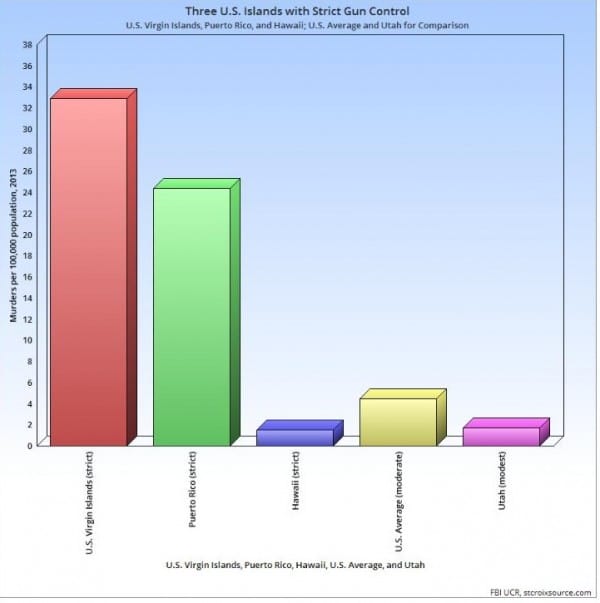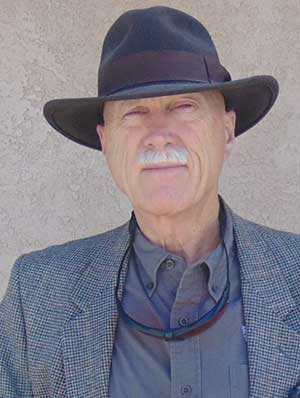By Dean Weingarten


Arizona – -(Ammoland.com)- Strict controls on the ownership and use of guns have been enacted in a number of polities in the United States. One of the supposed purposes of such laws is to reduce the murder rate. Murder rates in the FBI Uniform Crime Reports (UCR) consist of murder and non-negligent manslaughter.
When strict controls do not produce low murder rates, such as in Chicago or Washington D.C., the claim is made that the problem is the easy access to guns in areas outside of the polity with the strict controls. In Washington, D.C., it is claimed that criminals can easily obtain guns in Virginia. In Chicago, gun shops in Indiana are blamed as the source of guns.
Here is a look at three island polities that are under U.S. Jurisdiction that have implemented strict controls on gun purchases and ownership. These islands must be reached by air travel, where the carry of firearms is highly regulated and restricted, or by ship. If the problem with crime rates in Washington, D.C. and Chicago, or even New York City, is caused by the inflow of guns from areas with less restrictions on the purchase and ownership of guns, these polities should show a decrease in murder rates, as criminals cannot simply drive across state lines to obtain firearms.
Murder rates have been selected because they are the most carefully reported and investigated crimes, so they provide the best index of unjustified violence.
First island polity: The United States Virgin Islands.
The U.S. Virgin Islands has extremely restrictive gun control. No guns are allowed to be legally owned without permission from the Police Commissioner. His discretion is complete and final. Even antique guns are subject to his approval. Approval is hard to get, and involves a lengthy process.
476. Collections of antique firearms; certificates of uselessness. No provision hereof shall prevent that private collections of antique firearms, which may not be used as weapons. be preserved and maintained and that their owners possess them as ornaments or as matters of curiosity, nor the collections of firearms kept as relics, but for the preservation of any weapon of those included in this section the prior inspection thereof and approval therefor by the Commissioner shall be necessary and he shall render such firearms unless, so that the same may not be used as such. The Commissioner shall issue a certificate of uselessness of all the weapons possessed under the provisions of this section, and the possession of any firearm not included in said certificate shall be subject to all the provisions hereof. ****
The U.S. Virgin Islands were purchased from Denmark in 1917. They have local self government and elect their own Governor. But self government with extremely restrictive gun laws has not resulted in a low murder rate. The murder rate in the U.S. Virgin Islands was 32.9 per 100,000 in 2013, down sharply from the previous year, but still over seven times as high as the average murder rate for the entire United States, which was 4.5 per 100,000 in 2013.
Second Island Polity: Puerto Rico.
Puerto Rico has been under United States administration from 1898, when the United States took possession of the Island from Spain in the Spanish – American war. Puerto Ricans have been U.S. citizens since 1917. Puerto Rico has had extremely restrictive laws. All guns are required to be licensed and registered. The difficulty of obtaining a permit to purchase is time-consuming and expensive. No ammunition can be purchased unless it is for a firearm specifically mentioned on the gun license. The murder rate in Puerto Rico in 2013 was 24.4 per 100,000 population. That is over 5 times the average rate for the entire United States.
In June of 2015, a Puerto Rico judge ruled most of Puerto Rico’s gun laws unconstitutional. It is too early to determine if the ruling will have an effect on the murder rate. The ruling is likely to be appealed to the Puerto Rico Supreme Court.
Third Island Polity: Hawaii.
Hawaii was annexed as a United States territory in 1900, two years after the acquisition of Puerto Rico and 17 years before the acquisition of the U.S. Virgin Islands. Hawaii became a state in 1959. Hawaii, unlike the U.S. Virgin Islands or Puerto Rico, has a state Constitution with a segment identical to the U.S. Constitution’s Second Amendment, protecting the right to keep and bear arms.
Hawaii has strict gun control, but not as strict as the U.S. Virgin Islands. The restrictions are similar to the restrictions in Puerto Rico. All guns have been required to be registered since 1994, but guns possessed before the 1994 legislation was passed are grandfathered in. There are lawsuits pending that challenge the constitutionality of some of the Hawaiian gun laws, but the laws are still in effect as of 2015.
The murder rate in Hawaii is much lower than the average in the United States. In 2013 the murder rate was 1.5 per 100,000 population, about one third of the United States average or 4.5 per 100,000.
Three United States island polities with quite similar, strict, gun control laws. Two have murder rates more than 7 and 5 times greater than the United States average; one has a murder rate one third as great as the United States average.
It is clear that the gun control laws are not a major factor in the rate of murder. It is highly unlikely that effects of stricter gun laws, such as those pushed by former Mayor Bloomberg’s organizations, will have any measurable effect on the homicide rate in Chicago, Washington D.C., or in New York City. Many of the polities with far less restrictive gun laws on the purchase and possession of firearms, have far lower murder rates, such as Vermont, with 1.6 per 100,000; or Utah, with 1.7 per 100,000.
A major problem with trying to lower murder rates with gun laws aimed at restricting the entire population’s access to firearms is that only a tiny number of guns are needed to supply those involved in violent crime. From an economic perspective, it does not matter much if you attempt to fill a bucket from a small pond or an ocean; filling the bucket is easy in either case.
Murders are committed by a tiny percentage of the population. David Kennedy’s research indicates that even in urban areas with high crime rates, that percentage is less than one half of one percent of the population. From chattanoogan.com:
The same is true about people. “We now know that homicide and gun violence are overwhelmingly concentrated among serious offenders operating in groups: gangs, drug crews, and the like representing under half of one percent of a city’s population who commit half to three-quarters of all murders.”
There have been numerous studies on the effects of implementing strict controls on the purchase and ownership of firearms in the United States. The controls appear to have no effect or to be associated with somewhat greater homicide rates. The controls on gun purchase and ownership are slightly less strict in Hawaii than they are in the U.S. Virgin Islands, yet the murder rate in Hawaii is at least 20 times lower. Utah or Vermont have only modest controls on purchase and possession of firearms, yet their murder rate is similar to Hawaii’s. It is the demographics of the population, and how they perceive the effectiveness of the justice system that controls the murder rate. Legal access to weapons has little effect.
c2014 by Dean Weingarten: Permission to share is granted when this notice is included. Link to Gun Watch
About Dean Weingarten;
Dean Weingarten has been a peace officer, a military officer, was on the University of Wisconsin Pistol Team for four years, and was first certified to teach firearms safety in 1973. He taught the Arizona concealed carry course for fifteen years until the goal of constitutional carry was attained. He has degrees in meteorology and mining engineering, and recently retired from the Department of Defense after a 30 year career in Army Research, Development, Testing, and Evaluation.

Dean Weingarten: You did a good presentation using the chart. It proved your point. Could you do a presentation of the murders and wounding of American Citizens in the Cities of Ca, Chicago, Minn, Mon, Pa, Md and a few other States that have major gun controls? I would love to see a comparison.
GET IT RIGHT!!!! That idjit said he had ALREADY been to 57 States and had only ONE more to go. My old time arithmetic of 57 + 1 equals 58!!!!
He was even worse than we thought and getting MUCH worse!
I’m pretty sure your comment was tongue and cheek but even with all the U.S. Territories that I can think of; Guam, Puerto Rico, U.S. Virgin Islands, Northern Mariana Islands, and American Samoa, it still doesn’t add up to 57, though it I guess it would depends on what your definition of a territory is as well. With the wide latitude this President takes on so many things, who the hell knows.
https://en.wikipedia.org/wiki/Territories_of_the_United_States
Are these three U.S. islands part of the 57 States Obama has referred to in a past speech?
…..I lived on the islands of St Croix and St. Thomas nearly 2 years recently. FEAR of going out after dark or even near dark by white folks was palpable. One white man, an artist, was murdered a few blocks from me. So, then I moved to St Maarten. One white couple was hacked to death by their own black security guards using machetes. A friends 10 year old boy had a knife stuck to his throat by 2 blacks who demanded and got his cell phone given to him by anxious parents. Another friend was robbed in the middle… Read more »